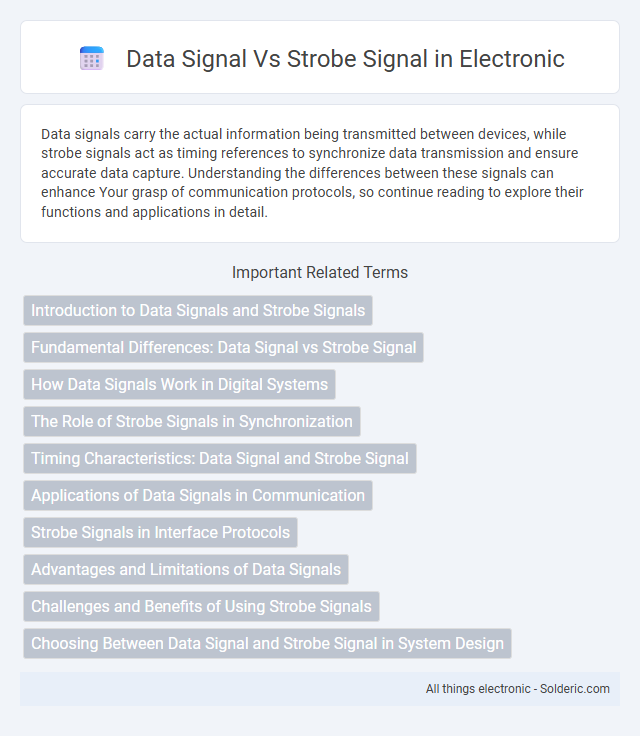Data signals carry the actual information being transmitted between devices, while strobe signals act as timing references to synchronize data transmission and ensure accurate data capture. Understanding the differences between these signals can enhance Your grasp of communication protocols, so continue reading to explore their functions and applications in detail.
Comparison Table
| Aspect | Data Signal | Strobe Signal |
|---|---|---|
| Definition | Carries the actual data bits in digital communication. | Timing reference signal used to indicate when data bits are valid. |
| Function | Transfers information content. | Coordinates data sampling or latching. |
| Signal Type | Variable, based on data being sent (logic 0 or 1). | Usually a periodic pulse or toggle signal. |
| Timing Dependency | Requires synchronization to be correctly interpreted. | Provides synchronization for data signals. |
| Example Applications | Data buses, serial communication lines. | I2C clock, USB strobe, synchronous interfaces. |
| Importance | Holds information content essential for processing. | Ensures accurate data capture and timing integrity. |
Introduction to Data Signals and Strobe Signals
Data signals carry the actual binary information between devices, representing logical states like 0s and 1s crucial for digital communication. Strobe signals serve as timing references that indicate when data signals are valid and should be sampled, ensuring precise synchronization in data transfers. Your system relies on the accurate coordination between data and strobe signals to maintain reliable and error-free communication.
Fundamental Differences: Data Signal vs Strobe Signal
Data signals carry binary information representing the actual content or payload transmitted between devices, while strobe signals function as timing references that indicate when data bits should be sampled or latched. Unlike data signals, which fluctuate based on the information being sent, strobe signals have consistent timing characteristics and synchronize data transmission to ensure accurate capture. The fundamental difference lies in their roles: data signals convey value, whereas strobe signals govern timing for reliable data interpretation.
How Data Signals Work in Digital Systems
Data signals in digital systems represent binary information using voltage levels that switch between high and low states to encode bits. These signals are transmitted along data lines and interpreted by receiving devices based on timing references, ensuring accurate bit recognition. Your digital system relies on precise synchronization between data signals and strobe signals to correctly capture and process the transmitted information.
The Role of Strobe Signals in Synchronization
Strobe signals play a crucial role in synchronization by providing precise timing cues that indicate when data signals are valid and should be sampled. Unlike data signals that carry the information payload, strobe signals ensure accurate data capture by aligning the reading process with the exact moment data is stable. This synchronization mechanism minimizes data errors and improves system reliability in high-speed communication and digital circuit operations.
Timing Characteristics: Data Signal and Strobe Signal
Data signals carry the actual information bits, while strobe signals provide precise timing references for data sampling, ensuring accurate data transfer. Timing characteristics of data signals involve setup and hold times relative to clock edges, whereas strobe signals are designed to latch data at specific intervals, minimizing timing uncertainties. Ensuring proper synchronization between your data and strobe signals optimizes communication reliability and system performance.
Applications of Data Signals in Communication
Data signals are crucial in communication systems for transmitting information between devices, enabling efficient data transfer in applications such as networking, digital telephony, and wireless communication. These signals carry binary data that represent meaningful information, allowing your devices to interpret and process commands or messages accurately. Strobe signals, in comparison, are primarily used for timing control and synchronization rather than carrying data content.
Strobe Signals in Interface Protocols
Strobe signals in interface protocols serve as timing references that indicate when data on the bus is valid and ready for capture, enhancing synchronization between devices. Unlike continuous data signals, strobe signals pulse at specific intervals to trigger data latching, minimizing timing errors and improving communication reliability. Understanding the role of strobe signals helps optimize your system's performance by ensuring accurate data transfer timing.
Advantages and Limitations of Data Signals
Data signals offer precise timing and accurate representation of information, enabling efficient communication in digital systems. Their primary advantage lies in the ability to carry complex data patterns, supporting higher data rates and improved signal integrity through error detection and correction mechanisms. Limitations include susceptibility to noise and signal degradation over long distances, requiring amplification or regeneration to maintain signal quality.
Challenges and Benefits of Using Strobe Signals
Strobe signals offer precise timing control by indicating the exact moment data should be captured, reducing timing uncertainty in data transmission but can introduce design complexity due to the need for synchronized clock and strobe coordination. They enhance signal integrity in high-speed communication by minimizing setup and hold time violations, leading to improved data reliability and reduced error rates. The challenges include increased wiring and potential signal skew, requiring careful PCB layout and timing analysis to fully leverage the strobe signal benefits.
Choosing Between Data Signal and Strobe Signal in System Design
Choosing between data signal and strobe signal in system design depends on timing accuracy and data integrity requirements; data signals carry the actual information bits, while strobe signals provide timing references to synchronize data sampling. Strobe-based designs reduce timing uncertainty by using a dedicated timing pulse, enhancing signal reliability in high-speed communication and memory interfaces. Engineers prioritize strobe signals in systems requiring precise timing alignment, such as DDR memory, whereas simpler systems may rely solely on data signals for cost efficiency.
data signal vs strobe signal Infographic

 solderic.com
solderic.com